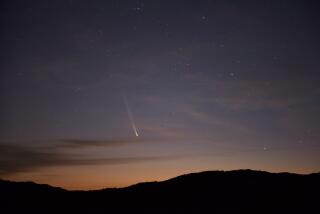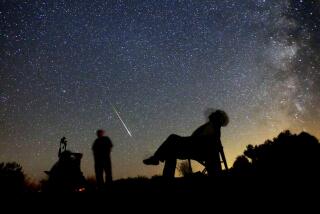Comet Puts On Popular Late Late Show : Dawn’s Early Light Finds Enthusiasts Seizing Opportunity of a Lifetime
A four-car caravan pulled into a lonely mountain cut overlooking Lake Elsinore at 3:30 a.m. Sunday and one occupant bounded over to a burly man at the cliff’s edge.
“Can you see it yet?” the man asked federal meat inspector Terry Maynard. “I wouldn’t know it if the thing sat on my nose,” Maynard confessed, scanning the southeastern horizon through a pair of hefty binoculars as more people bundled against the early morning chill tumbled out of cars to set up tripods, cameras and telescopes.
“There it is!” someone said, and a half-dozen pairs of binoculars and assorted telescopes jerked in unison toward a ghostly wisp of light just two hands above silhouetted hilltops in the southeastern sky.
In a scene repeated along winding Ortega Highway from San Juan Capistrano into Riverside county--and elsewhere--over the weekend, dozens of strangers shared the experience of a lifetime as Halley’s comet revealed itself while most of Southern California slept.
Sunday morning was one of the last chances to view the celestial visitor that sweeps around the sun once every 76 years. All those who gathered above Lake Elsinore were determined not to miss it, whether they had to forgo sleep or rouse themselves in the dead of night.
“Look at it this way,” explained Maynard, a 39-year-old meat inspector from Huntington Park who got up at 1 a.m. and drove more than 80 miles into the peaks of the Cleveland National Forest to see Halley’s comet.
“We’re the fortunate ones. This happens only once in our lifetimes,” Maynard said. “Think of it! Do you suppose our grandchildren will see it?”
Once they spotted it, stargazers drifted from telescope to telescope for a better view of the faint glow in the sky. Most ended up at Lorry Lup’s homemade telescope, a cardboard cannon propped on a beach chair and aimed at the comet named for Sir Edmund Halley.
Halley, an eminent English astronomer, deduced that comets seen in the years 1456, 1531 and 1607 were one and the same. In 1682, he correctly calculated its 76-year orbit around the sun but did not live long enough to see its return.
Halley’s comet has been visible intermittently since last October, and Lup has hauled her 12-inch reflecting telescope--affectionately called “the light bucket”--out to the wilderness to view the celestial curiosity 15 times so far.
Some Have ‘Funny Impression’
“A lot of people have a really funny impression of what it’s going to be like,” said Lup, a 32-year-old picture frame maker from Costa Mesa and former astronomy major at Cal State San Diego. “They expect to see it really large, with a long tail moving across the sky. Of course it doesn’t at all.”
Patiently, the amateur astronomer gave introductory stargazing lessons to all who happened by her scope, as blues music wafted from her friend’s van over the oak-studded valleys.
“I feel good because so many people came around to look through it. There’s usually never this many people out who are interested in the stars. It’s truly amazing.”
Maynard was also impressed by the growing number of cars that rumbled along a three-mile dirt road to the mountain lookout.
“It’s like opening day of deer season! There are people everywhere,” Maynard said. And he eagerly shared his just-acquired knowledge with the new arrivals.
“It kinda looks like a star cluster,” he remarked to a stranger, pointing to the glowing orb with its faint stream of a tail. He hastened to add, “but I don’t know that much about astrology.”
Nearby, Karleen Washam, a 30-year-old court reporter trainee, hurried to join her children and husband, Mark, as he brought the comet into focus in the telescope he gave her for Christmas expressly to view it.
Trip Was Family’s Fifth
“I looked through all of ‘em and I still like my scope the best,” she said with a grin as 5 1/2-year-old Joseph and 2 1/2-year-old Kelly demanded to be picked up for a quick look.
Sunday’s trip was the Westminster family’s fifth into the darkness to view Halley’s comet.
“It’s so easy for me to get up now. (Saturday) night I just picked up the kids in their underwear, bundled them up in blankets and put them in the car. They’re used to it by now,” Karleen Washam said. “Joseph says Halley’s comet is ‘real rad.’ ”
Across the way, Alison Radford, 11, wriggled underneath a blanket on the hood of her parents’ car.
“I woke up just in time to see it. I think it’s spectacular,” said the sixth-grader at La Tierra Elementary School in Mission Viejo. “I really wanted to see it because it only comes every 76 years,” she confided.
“And I’m going to take real good care of myself so I can see it when it comes back the next time.”
Radford, her parents and 9-year-old brother, David, drove up with neighbor Richard Siemon, 37, of Mission Viejo. The packaging company owner set up his two-year-old telescope at cliff’s edge just as a rosy glow at horizon’s edge announced the coming of dawn.
‘Brighter Than I Thought’
“Actually, it’s brighter than what I thought it would be,” Siemon said. “Getting up a little early to appreciate it is worth it.”
Not everyone who awakened early was so sure. Maynard’s friend, electronics engineer Jeff Hayner, 40, of Lake Elsinore, shivered as he looked down toward his home below.
“This is the first night I’ve been willing to get up this early in the morning,” Hayner said. “If it wasn’t for him wanting to see this thing so bad,” he said, gesturing to Maynard, “I’d still be in bed.”
But Maynard remained awe-struck and grateful at the chance. “That’s it after tonight. The thrill is over,” he said as the strains of B.B. King’s “The Thrill Is Gone” emanated from Lup’s van.
By 5:30, the sun streamed over the horizon. One by one the cars drifted back down the dirt road, piloted by haggard drivers.
Lup, her relatives and friends huddled around their van, some of them polishing off the last of the fortified coffee in the huge thermos.
Breakfast, Then Sleep
Asked what they would do next, she did not mince words: “Breakfast, head home, shower, sleep.”
Mark Washam, 32, an air traffic controller at Los Angeles International Airport, made a final search of the dawn sky for more familiar objects like Jupiter and Venus.
He gazed fondly at his 2-year-old daughter as she gamboled up a hillside, two terrier pups yapping at her heels. “What I really like about this is that when my little girl is 78, she can say, ‘I remember seeing the comet.’ ”
Karleen Washam drained her coffee thermos and told a new friend she would be out again to see Halley’s comet when it is visible for the last time in April.
“On April 10th or 11th, it will be at it’s brightest and closest and you’ll be able to see it a lot earlier. Baja (California) is supposed to be the best place,” she said.
Nodding in her husband’s direction, she whispered conspiratorially, “I think I’m going to talk him into going down to Baja to see it again.”
Contributing to this story were Times staff members Robert Magnuson and Louis Sahagun.
More to Read
Sign up for The Wild
We’ll help you find the best places to hike, bike and run, as well as the perfect silent spots for meditation and yoga.
You may occasionally receive promotional content from the Los Angeles Times.






